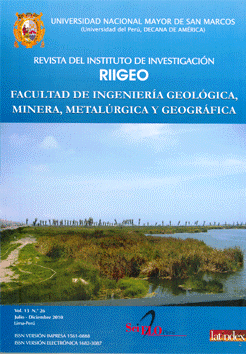Cellulase production by cell immobilization for the treatment of industrial effluents lignocellulose
DOI:
https://doi.org/10.15381/iigeo.v13i26.507Keywords:
freeze, spore, cellulase, cellulose, bagasseAbstract
Industrial effluent treatment requires highly polluting alternatives designed to lower costs and greater feasibility for adoption by the respective industrial sector. Enzymatic bioconversion of lignocellulosic waste constitutes a promising alternative for the decontamination of such effluents on behalf of our ecosystems. The immobilization of microorganisms in industrial biotechnological production of enzymes is an increase in production, ease of unit operations and reduced costs. The search for new culture media for biotechnology products desired as cellulase is also vital to raise the level of production of these compounds. The objectives were immobilized spores and assessing the production of cellulases in different culture media based on sugarcane bagasse. Agar was used to immobilize the 2, 4 and 6% as carriers. The addition of the microorganism was carried out in the form of spores (106/mL) diluted in 0.1% Tween 80 in physiological saline at 45 ° C in agar solutions at the same temperature. Technique was used on vegetable oil droplet at 4 ° C to form spheres. Model was designed a stirred tank bioreactor, where culture media was tested compounds induce dry bagasse (4-6% moisture, 60 Mesh) as a carbon source to 4, 8, 16%, ammonium sulfate 0.1; 0.2 and 0.3%, magnesium sulfate 0.5, 1 and 2% potassium diphosphate 0.1, 0.2 and 0.3% and saline 0.9% as final diluent. Incubated 25 º C, agitated with 100 cc air / min for 5 days. Cellulolytic activity was evaluated on microcrystalline cellulose by measuring spectrophotometrically the release of glucose during the 5 days of incubation. The results demonstrate the effectiveness of the three systems of detention, projecting the system consisting of agar to 2% due to increased microbial density achieved on the surface of the spheres. Systems to 4 and 6% showed lower microbial density on the surfaces of the spheres, due to the difficulty of the spores to germinate within the agar. The medium composed of sugar cane bagasse to 4%, 0.1% ammonium sulfate, magnesium sulfate 0.5% and potassium dihydrogenphosphate 0.2% higher cellulolytic activity induced by 3 days of fermentation With Aspergillus niger.Downloads
Published
Issue
Section
License
Copyright (c) 2010 Mario Alcarraz Curi, Abad Flores Paucarima, Juan de Dios Godoy Alcarraz

This work is licensed under a Creative Commons Attribution-NonCommercial-ShareAlike 4.0 International License.
AUTHORS RETAIN THEIR RIGHTS:
a. Authors retain their trade mark rights and patent, and also on any process or procedure described in the article.
b. Authors retain their right to share, copy, distribute, perform and publicly communicate their article (eg, to place their article in an institutional repository or publish it in a book), with an acknowledgment of its initial publication in the Rev. Inst. investig. Fac. minas metal cienc. geogr.
c. Authors retain theirs right to make a subsequent publication of their work, to use the article or any part thereof (eg a compilation of his papers, lecture notes, thesis, or a book), always indicating the source of publication (the originator of the work, journal, volume, number and date).























